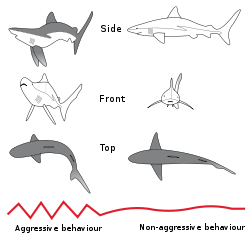
Shark threat display
Encyclopedia

Shark
Sharks are a type of fish with a full cartilaginous skeleton and a highly streamlined body. The earliest known sharks date from more than 420 million years ago....
s when they feel threatened or protective. It consists of a contorting of the body into a series of "ritualized" postures coupled with an exaggerated swimming style. It is most frequently observed in the grey reef shark (Carcharhinus amblyrhynchos), although it has been seen in other sharks.
When threatened, the grey reef shark lifts its snout, holds its pectoral fins stiffly downwards, arches its back and holds its tail sideways. It often accompanies this posture by an exaggerated swimming pattern in a yawing figure-of-eight. The speed and intensity of the display increases as the perceived threat increases (for instance when the possible escape routes for the shark are restricted) and may be interspersed with quick slashing attacks followed by a rapid retreat. The behaviour is highly ritualized and predictable, and is believed to serve some role in normal social interaction. Sharks displaying this behaviour are normally on the verge of either attacking or fleeing, and it indicates a possible non-predatory basis for attacks on humans.
Similar, but less exaggerated, displays have been observed in 23 other shark species, among them the Galapagos shark
Galapagos shark
The Galapagos shark is a species of requiem shark, family Carcharhinidae, found worldwide. This species favors clear reef environments around oceanic islands, where it is often the most abundant shark species...
(Carcharhinus galapagensis), the silky shark
Silky shark
The silky shark is a species of requiem shark, family Carcharhinidae, named for the smooth texture of its skin. It is one of the most abundant sharks in the pelagic zone, and can be found around the world in tropical waters. Highly mobile and migratory, this shark is most often found over the edge...
(Carcharhinus falciformis), the blacktip shark
Blacktip shark
The blacktip shark is a species of requiem shark, family Carcharhinidae. It is common to coastal tropical and subtropical waters around the world, including brackish habitats. Genetic analyses have revealed substantial variation within this species, with populations from the western Atlantic Ocean...
(Carcharhinus limbatus), the blacknose shark
Blacknose shark
The blacknose shark is a species of requiem shark, family Carcharhinidae, common in the tropical and subtropical waters of the western Atlantic Ocean. This species generally inhabits coastal seagrass, sand, or rubble habitats, with adults preferring deeper water than juveniles...
(Carcharhinus acronotus), the great white shark
Great white shark
The great white shark, scientific name Carcharodon carcharias, also known as the great white, white pointer, white shark, or white death, is a large lamniform shark found in coastal surface waters in all major oceans. It is known for its size, with the largest individuals known to have approached...
(Carcharodon carcharias), the tiger shark
Tiger shark
The tiger sharks, Galeocerdo cuvier, is a species of requiem shark and the only member of the genus Galeocerdo. Commonly known as sea tigers, tiger sharks are relatively large macropredators, capable of attaining a length of over . It is found in many tropical and temperate waters, and is...
(Galeocerdo cuvier), the bull shark
Bull shark
The bull shark, Carcharhinus leucas, also known as Zambezi shark or unofficially known as Zambi in Africa and Nicaragua shark in Nicaragua, is a shark common worldwide in warm, shallow waters along coasts and in rivers...
(Carcharhinus leucas) and others. It is believed that the breaching and slapping of the tail on the surface of the water exhibited by great white shark
Great white shark
The great white shark, scientific name Carcharodon carcharias, also known as the great white, white pointer, white shark, or white death, is a large lamniform shark found in coastal surface waters in all major oceans. It is known for its size, with the largest individuals known to have approached...
s may be an agonistic display, but in this case based on competition for food rather than a perceived danger.

